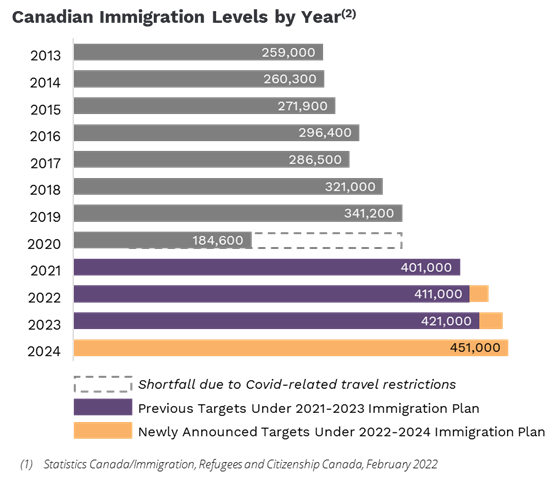

We were very intrigued by their bold mission to advocate for policies and programs that would increase Canada’s population to 100 million by 2100. The Century Initiative argues that our long-term success depends on our ability to scale our population over the course of this century while ensuring that infrastructure development, social programs, and public support for this expansion keep pace.
Why is immigration so important?
Their view is that the world is changing at a rapid pace, and Canada is falling behind. With an aging population, low birth rate, and shrinking workforce, Canada’s annual GDP growth will decline, along with our influence on the world stage if we don’t take action to significantly increase immigration. Without immigration, Canada’s population will start to shrink in twenty years given our inability to naturally replace our aging population with new births. According to The Conference Board of Canada, by 2033 immigration will be the sole factor driving population growth in Canada.1
Canada currently has a population of ~38 million. Last year Canada welcomed over 405,000 new permanent residents, the greatest number of new immigrants welcomed in one year. The increase was in part driven by the need to make up for the drop in immigration in 2020 caused by the pandemic with an important focus on addressing labour shortages in Canada.

Immigration already accounts for almost 100% of labour force growth2 and to ensure Canada has the workers it needs to fill critical labour market gaps and support a strong economy into the future, the Government of Canada announced last month its plans to further increase its already elevated immigration targets over the next three years. Canada’s 2022-2024 Immigration Plan will strive to welcome 432,000 permanent residents in 2022, 447,000 in 2023 and 451,000 in 2024.3 These new levels represent the highest targets in Canadian history. The enhanced plan focuses on attracting skilled workers with over 56% arriving under the economic class pathway.
Continuing to increase immigration will be very important for our country with five million Canadians set to retire by the end of this decade, the worker to retiree ratio will drop down to only 3:1 increasing the percentage of economically dependent Canadians and making it more challenging for the relatively smaller working population and tax base to fund government run programs and institutions including our health care system.4
Canada is one of the most urbanized countries in the world. Over 80% of Canadians live in cities.
Most newcomers to Canada choose to settle in the country’s largest urban centres, where they are often attracted to the concentration of diversified employment opportunities, urban amenities, and communities. Each year the Greater Toronto Area (‘GTA’), Canada’s economic engine, welcomes on average more than 100,000 immigrants to the region, which increases demand for housing, services, and the need for better infrastructure that can keep up. The GTA is projected to be the fastest growing region, with its population increasing by 2.9 million, or 40.9 percent, from 7.1 million in 2020 to almost 10.0 million by 2046.5 The GTA is also expected to remain the region in Ontario with the youngest age structure as a result of strong international migration and positive natural increase despite an inevitable shift to an older age structure across the entire province.5 Overall Ontario’s population is projected to increase by 35.8 percent, or almost 5.3 million, over the next 26 years, from an estimated 14.7 million in 2020 to over 20.0 million by 2046.
Strong population growth is a fundamental component of any region’s economic prosperity and it underpins our investment thesis in the GTA and broader Greater Golden Horseshoe region.
With a growing number of people immigrating to the GTA and migrating from other parts of Canada to the GTA, as well as the overall population growth in Ontario, the need to increase the supply of new homes in the GTA, Greater Golden Horseshoe region and broadly across Ontario is absolutely critical. Not only is it critical for the obvious reason of providing shelter for newcomers, but housing and housing affordability are critical for the economic prosperity of the country and our ability to continue to attract and welcome needed immigrants to Canada. Attracting more people to our cities allows us to share the cost of key services such as hospitals, roads, libraries, and policing across a larger tax base.
As the Century Initiative notes, Canada already has a large number of immigrants, who are a source of economic strength and diversity. Our openness as a country is a competitive advantage, and it must remain that way for decades to come.
Sources: